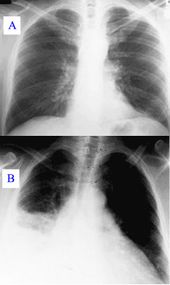Diagnosis of pneumonia is
relatively easy, requiring not much more than a chest x-ray to confirm the
presence of fluid in the lungs. In order to properly treat pneumonia, the
source must first be determined, which can be more complicated than a simple
chest x-ray. M. pneumoniae is difficult to culture and usually only grows well in blood serum medium, and then only very slowly.
well in blood serum medium, and then only very slowly.
Sputum culture testing is one way to diagnose M. pneumoniae infection. Sputum is comprised of lung secretions that are expelled through coughing. Sputum specimens are collected by having the patient cough into a cup. The specimens are then plated onto blood serum agar inoculated with penicillin, which does not kill M. pneumoniae, but does kill most other bacteria. This test will confirm the presence of M. pneumoniae, but it is too time consuming for clinical applications.
The most common way to diagnose M. pneumoniae is through serum testing. Serum testing involves looking for specific Immunoglobulin M antibodies that indicate the
presence of M. pneumoniae. Serum tests can detect the specific IgM antibodies with 90% accuracy nine days after onset of symptoms and with 40% accuracy seven to eight days after onset of symptoms.